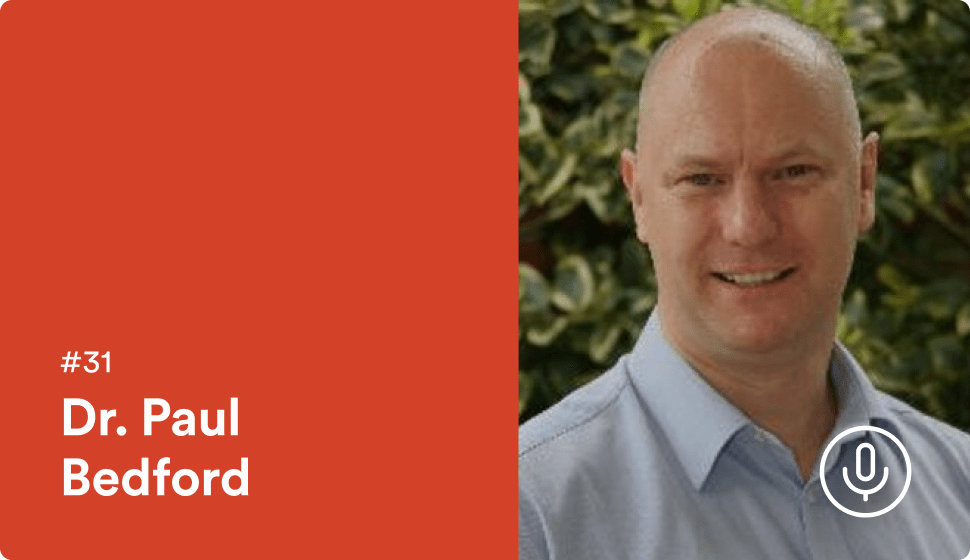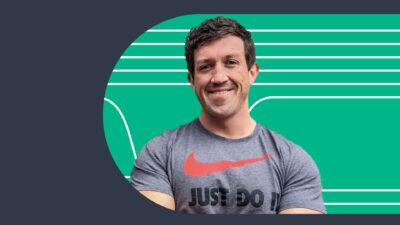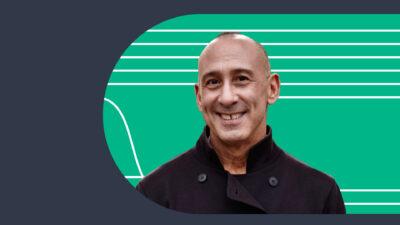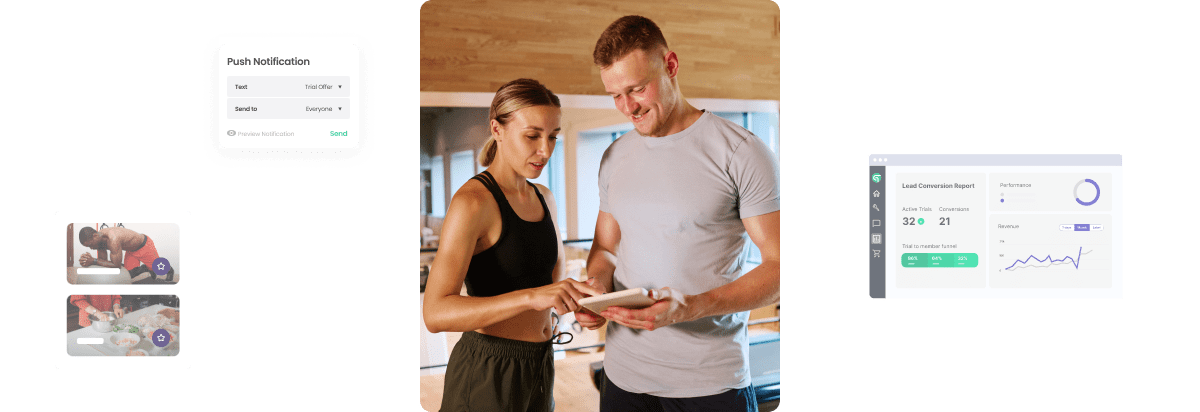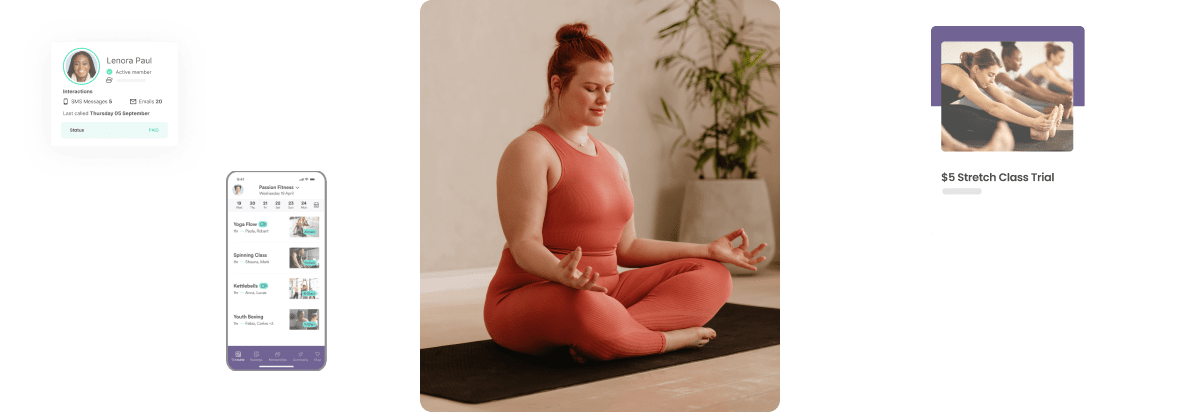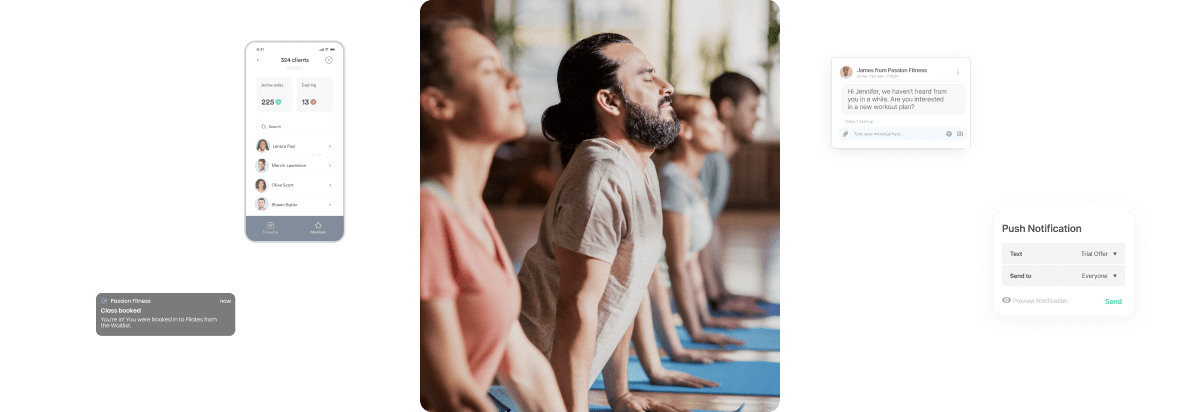This week we were so excited to talk to Dr. Paul Bedford, an industry-leading expert on retention and the owner of Retention Guru, which helps independent gyms and larger international franchises with their retention strategies.
Paul talks to us about the fundamentals of a great retention strategy, creating an engaging customer experience in a virtual setting and the key to implementing change across multiple location franchises.
To get in contact with Paul you can find him at [email protected]
This podcast is brought to you by Glofox, a gym software management company. If you are looking to accelerate growth, work efficiently and deliver a well-branded boutique customer experience, check us out at www.glofox.com
Skip ahead to:
Episode Link
This episode of The Fitness Founders Podcast can be found on Spotify, Apple Podcasts, and anywhere you get your podcasts.
5 Key Takeaways From This Episode
1. Don’t Leave Gaps Between the Sales and Onboarding
It’s easy to think that the member journey starts when the person walks in the door. In reality, however, onboarding a member correctly has it’s origins in the sales process. The salesperson does a great job of building a relationship with the customer. In the long run, though, they will not be building a long term relationship with the customer.
There is a gap between where the salesperson’s job ends and the onboarding person’s job begins. Within this gap, the new member can feel lost and the good relationship built up with the salesperson can lessen in value. According to Dr. Bedford, there needs to be an overlap so there is smooth continuity in the person’s journey from converted lead to fully onboarded member. Check out his “first date” analogy in the episode!
2. Create a Watertight Onboarding Plan
There is no “one size fits all” when it comes to a member joining your gym. Dr. Bedford explains the three types of members you would typically find signing up for a gym membership. They are:
- The New Member: A person who has never really joined a gym before.
- The Savvy Member: This person is an experienced gym-goer who largely knows what they are doing.
- The Yo-Yo Member: Someone who has been a regular member of a gym at least once before but has not committed to it long term.
The mistake some gyms make is that the Yo-Yo Member is treated as a Savvy Member as they answer “yes” to the question “have you ever been a member of a gym before?” when they really should be treated as a new member. Then they will get the support needed to ensure they don’t leave.
Dr. Bedford points out that your onboarding team needs to be able to identify who needs more support and who needs less. This means asking the right questions that make the customer self-selects their category rather than the trainer. Then allocate the proper resources to back up each level of support.
3. Map Out The Customer Journey
Getting the touchpoints right is so important to getting your customer journey right. Then one thing you should not do is bombard them constantly with sales messaging as they will quickly disengage. What you need to do is map out the touchpoints in the customer journey based on what the member is expecting.
Dr. Bedford gives a quick overview of what this playbook looks like in reality. First of all map out the timeline of the journey from the sales process onwards. Then identify what the customer service is at each stage and what the emotional experience is at these stages. Finally, layer on top the means of communication, be it SMS, email, or a combination of both.
4. You Need to Develop Your Online Product
Something that has been echoed recently by a few of our recent guests is that the quality of your recording needs to evolve over time. In the beginning, current members will be forgiving about technical hiccups but may not be after day 20. Similarly, new members will not be as patient if your online product is no up to scratch. It’s essential to learn and develop your recorded workouts and figure out quickly what works and what doesn’t.
An example Dr. Bedford points out is that some instructors will be great on-screen while others are more suited to in-person classes. He also references a recent article by Life Fitness Director of Digital Experience Leon Rudge which says there are some things that you can get away with in a crisis but that can’t be your long term strategy. You need to figure out how to get the best out of your team and resources to deliver an online offering that shines
5. Implementing a Retention Strategy Across A Franchise
If you are the head of a franchise, its never been more important to make sure there is cohesion across all your locations. Retaining members in this new world is the key to survival so everyone needs to be on the same page. Once you have developed the playbook for retention, you need a way to get all your franchise locations onboard.
Dr. Bedford explains that you need to show them clearly the data that proves the value of your retention playbook. This is not just from a customer experience standpoint, but from a bottom-line standpoint. On top of this franchise owners need to ensure that their managers understand and deliver on the process that has been mapped out.
Transcript
Kevin:How is it going everyone? Welcome to The Fitness Founders Podcast. I’m Kevin Mannion, VP Marketing here at Glofox. This week we talk to Dr. Paul Bedford, industry-leading expert on retention and the owner of Retention Guru, which helps independent gyms and large international franchises with their retention strategies. Paul talks to us about the fundamentals of a great retention strategy, creating an engaging customer experience in a virtual setting, and the key to implementing change across multiple location franchises. Let’s get started.
Paul Bedford, welcome to the show.
Paul:Thank you very much.
Kevin:So maybe just tell us a little bit about yourself and your business.
Paul:Okay. So I have a business called Retention Guru, and I personally been working in the fitness industry for almost 30 years. Started as a gym instructor, worked my way through, ended up being a facilities manager. I’ve worked in both public and private sector. I stepped away from that a while ago to study academically. I studied Exercise Psychology at master’s degree level, and then get my PhD looking at how you apply behavior change approaches in health and fitness environment, which is really sort of then spawn the business. Because I was being asked by small business to help them increase the retention within their clubs and now that’s grown and it continues to grow and we work internationally in North America, Europe, Australia, and some in China as well.
Kevin:I suppose you are working with pretty broad range of customers. But sounds like effectively you’re working with a lot of this bigger box gyms working on retention strategies for them. Is that it?
Paul:Yeah. Look, it’s not say I don’t work with small sites. I work with a boxing club that’s just down the road from where I live. My daughter trains there, and I’m helping them, and it’s just two lads who got their own little club going. But I do work with some of the bigger organizations, people like Gold’s in the U.S, people like Anytime Fitness. I’ve worked with Marriott hotels, worked with The Gym Group here in the U.K, and also worked with lots of public entity type operations, and some of those have 30 sites as well, so. Yes, some of them are fairly big and very broad offerings.
Kevin:Yeah. So obviously the world I suppose has changed over the last few weeks. Tell us a little bit around what you’re seeing and some of the challenges that people are having with going online and with dealing with COVID.
Paul:I think first of all the things that I notice, there is obviously lots and lots of webinars at the moment about what to do with COVID-19 and what we are going to do on the way out. I see a lot people talking in absolutes and facts as if we know what the future’s going to hold. I really don’t think we do. I think we can speculate and I think that is okay to speculate, you know, a bit like if you’re old enough, people remember Y2K when the clocks on the last, 31st of December 1999 became the year 2000. Everybody thought the world is going to come to an end because they weren’t sure that technology was going to work, and then nothing happened. I’m not suggesting nothing’s going to happen here. Well, I think is really difficult to actually say, “These are the things…” I think we can speculate, but I don’t think anyone’s really talking in facts.
There are things that are going to be different. Things that I’ve seen particularly online, obviously it was a big rush for lot of people to go online. Personally, I’m participating some online training, and I’ve done for a long, long time. What I’m seeing is, again, I’m seeing people who have an agenda telling me the bricks and mortar clubs are dead, everybody’s going to be online, no one’s ever going to go back. I don’t believe that. I think a lot of people have gone online as customers, because there is no alternative. And I think as things return to whatever normal would be, you’ll have people who use clubs, you’ll have people who can stay online, and then you’ll have a hybrid model where you’ve got people who are like me. I go to a club twice a week and yet I train at home sort of three times a week as well with the stream process.
Kevin:Yeah. We’ll definitely dig in to a lot of future clip potentially look like. Or maybe to get started, I think your bread and butter is retention strategy. So can you just tell me what is, at a high level, what is a retention strategy?
Paul:Retention strategy is looking at a business and identifying where the critical points are where customers leave. Now, when we define retention within our business into our customers, it’s the period of time between when someone joins and when they leave. We measure that in months. Now, we’ll also measure the time between when they joined their first visit and their last visit. But sometimes if they might carry on paying even though they’ve stop visiting. We look for critical points in that period where customers are likely to dropout. And we’re able to run analysis that says, is it going to happen in the first 3 month, month 5, month 9. And when we’ve got back analysis, we can then start saying strategies for the business, because there is a very different strategy you need.
If your customers are leaving, let’s say, 70% of your customers go off to the first 2 months, there’s a real problem in the early stages, the onboarding, maybe the marketing sales process. If they’re staying for 3 years and then leaving, you’ve got a very different problem. So the strategy you need to employ has to be different. And it might be that you have a combination of those two things with one group of people were buying memberships and leaving quickly but another group of people seem to stay a lot longer. We’re using analysis to really dive into the business and say, these are the tactics you need to deploy in order to change the length of time people stay in your business.
Kevin:Now, I’m sure you’ve been through hundreds or thousands of these implementers a lot of these strategies in your time. I do know that every business you walk into are franchise that you walk into the prescription is going to be slightly different. But maybe let’s walkthrough some of the common mistakes people are making or common solutions people have at each stage and in the process. Maybe we’ll start with the sales process and I know maybe not where you spent a lot of the time but what kind of things of people may be doing in the sales processes that sets themselves up for early churn or creates things that are going to cause some trouble down the line.
Paul:I think one of the things that I commonly see is the sales person does a really good of building relationship with the customer. They’re not the person who’s going to have the long term relationship with the customer. And often there’s a gap between I’ve made the sale and then the sales person saying, “Oh okay, you need to get yourself booked in for an induction or an onboarding process, or you need to…” And they’re almost like, as soon as the customer signed up, they think their job is done. As far as they are concern their job is done and it is now someone else’s job to look after them. There needs to be an overlap there, so I often talk about, I say, the opportunities are in the gaps.
One of the gaps is often the handover between the sales process and the first visit or the next visit of the customer. I had really nice example, I wish I had thought of it, I do something similar myself but I didn’t go through the next part of it. A lot of sales process is almost like a one-night stand. So you got your staff, you look great, we’re really lovely, we talk to the person, we make a great impression and then after that evening, that’s it, it’s done. Well imagine that person wanted a relationship. You’ve gone through the first part of it. You’ve gone out on the first date. The person says, “Yeah, I want to continue this.” You go, “Well, that’s good. I’m really pleased about this but actually you’re not going to have any more dates with me.” Your relationship is going to be with somebody else. And they don’t hand them over to the other person, so there’s a disconnect. In the early stages, a lot of our process could really refine the way where they hand they customers over through the different stages, the inquiry stage, the joining stage, the onboarding stag. That’s where the gaps are.
Kevin:Got it. Yeah, I think that’s a great simple takeaway from a sales perspective. We move on a bit and talk about onboarding. I’m sure there’s a lot of gyms out there that actually do no onboarding. There’s others that have maybe 30, 90-day plans. What’s stir on how to think about creating an onboarding plan?
Paul:If you think about an onboarding plan, you need to separate your customers out into groups. Now, I do that with my clients in a very simplistic way. I say there is the new exerciser who’s never been a member of a gym before. There is the savvy exerciser who knows what to do. In fact, if they walk in today, without any real help or support with going to a workout. And then there’s a person in the middle of that that I call Yoyo. The yoyo customer is somebody who’s been a member of a gym before, maybe even the same gym, but they’ve never really stopped to exercise.
What happens is when people come in during the sales process, they get ask the question, “Have you ever been a member of a gym before?” Well, the new ones say no. The savvy say yes. But also the ones who’ve never really got going, the yoyo, they also say yes. Nothing get treated like a savvy person, when really they should be treated like a new person. That’s then continued with the onboarding process because they maybe perhaps a member of fitness team who says, “Have you been a member of a gym before?” The customer says, yes I have, the yoyo, what they have. And they get treated as if they understand and know what they are doing as opposed to identifying, well, actually, “Do you need support from me or is this something you’re comfortable getting on with yourself.”
I think early phases, really try to identify, even if you do it in most three groups. Simplify which types of customers we need support and then design your support around those two. Really there’s 2 types: people who need support and people who don’t need as much support. Design it out from there. And then you have to look at your resource, how many staff have you got, are you going to do a single onboarding appointment or are you going to do multiple appointments, is it going to be multiple, is it going to be one person on 2 or 3 appointments or is it going to be different instructors. You really start to have to play around with it and go, “What can we feasibly deliver within our business with the resources that we’ve got?”
Kevin:And at most take set amount of training for a trainer so they know how to ask those questions and really categorize those people accurate.
Paul:We’ve got 3 questions that we use for our clients. But when we give them to operators, we start the sentence with which one of these describes you best. It is like, “I’m new to exercise and I have never done this before”, “I’ve been an exerciser but I’ve struggled to keep it going” or “I’ve been an exerciser I pretty much know what I’m doing and I’m prepared to get on with it myself.” Now, just by asking those 3 questions, the customer self-select into which type of group they should be in as opposed to the trainer having to go, “Oh, I’ve listen to you and I think you are a yoyo but you might be new.” But the actual client goes, they say this describes me. And if you’re the first two, you say, well look, this is the support package we can offer you. You don’t have to take it but what we found is that customers who follow this support are more successful than people who try and do it alone. Now, if you’re there an experienced exerciser, you probably going to not want to do that. But I would present it to the experienced exerciser like, “This may not be of value to you but we have a support program. If you’d like, it looks like this. If not, here’s the alternative. This is what we could do as an alternative in terms of like quick start or just simple show round to get you going.” That does require training, but you’ll be surprise how quickly staff pick up on it. The biggest challenge I have is when the staff want to be the expert. In a they are really good is designing exercise programs and introducing the training. Where they are not really good is actually understanding the customer in their first experience is. That means, work around with empathy and clarification with questions.
Kevin:Yeah. Now, I know everything is online now but maybe let’s take a step forward to when things are opened a bit more or step back when they were open. The business you are working with, how are they getting the mix right between a digital touch points and personal touch points? How do they make those work together?
Paul:Are you talking about right now while the clubs are closed or are you talking about going forward?
Kevin:Let’s say going forward.
Paul:So going forward, I think if your content, if your digital content has value, you can send lots of it. What I do seen and have experiences when actually the only content that’s send out digitally is a sales message – buy this, buy this, buy this, 24-hour sale, 36-hour sale. Customers disengage with that really, really quickly. You have to use the strategy of content marketing in terms of sharing with them useful content. We’ve seen those with some technologies that you can contact customers every day to prompt them to exercise and then not be upset by that if they signed in to that process. So if they want like accountability, because we’re going to make you accountable every day. We’re not going to ask you to exercise every day. We’re going to make you accountable every day and we’re going to contact you. Then they’re fine. It’s this when they get bombarded digitally with office and sales messages and things like that.
Kevin:Yeah.
Paul:When they are in the club, I only say that there are different types of members. There are always customers who I don’t talk to anyone anyway. You know, I’m out training on my mountain bike at the moment in the mornings, probably 90% of the people I pass acknowledge me, 10% don’t. That’s probably true in the club as well. There are just some people who wouldn’t acknowledge you. But you wanted to show acknowledgement to show people, actually we recognize you turned up today and we value the fact that you turned up today. We appreciate that. From that, you can usually gage whether someone wants to interact with you. So the human, the face to face interactions, they can take place usually when someone is in and exercising. You need be mindful that you don’t create interruptions with your interactions. On the gym floor, we usually advice you know, if someone seeing resting between sets, you could speak to them. If they are transitioning, you could speak to them. But if they’re running flat out on the treadmill, leave them alone. It’s about being mindful. We’ve also seen customers are much more likely to talk to you on the way out than they are on the way in. Because on the way out, they want to, not almost boast about what they’ve done. One the way in, they just want to get in and get on with it. The early variation on that tends to be first thing in the morning where people just want to get in and get out on their way to work.
Kevin:I know; I’m asking since you do work with a lot of franchises. How do you systematize this? This rule book, how does it work in practice?
Paul:What you have to do is you have to map out the customer journey. What the customer is expected to experience. The way we draw out our timeline and we say, this is what happens in the sales process, this is what happens next. Then we would write out the behaviors that go with that, so that’s the actual customer service expectation. We would look at both the customer journey and customer service to think about what’s the overall experience, because the experience is the emotional connection to the journey and the service. And then we will look to lay digital on that. We are either using push notifications or SMS, or email, or combination. Often we use a combination now. And build it up step by step. We’ll do traditional testing where we will test different types of messages to see top of responses. We know what response we want. It’s a visit. We want them to visit again. Within franchise businesses, a lot of franchise owners are happy to step into tell me how to do this.
If you think about something like a McDonald’s or Starbucks, you don’t get a member or staff at Starbucks going, “Do you know what, I don’t think I’m going to add the gherkin today to the Big Mac. It’s like the gherkin goes in. It’s a process. The reason those businesses can grow and grow rapidly is they are process driven. It’s when you try and then make an experience on top of that which has an emotional connection. This is usually a little bit more challenging. The people who work really good at the process are sometimes not good as being emotional. No one is good at being emotional and not good on following processes. It’s about not trying to ask too much of people. You could always design it more complex to kind of ways to deliver it.
Kevin:I think one thing Paul said, I think maybe as we just finish off around this onboarding piece is the getting the person’s consent for the types of messages that you are sending them. Obviously, in the gym you don’t interrupt their run. The online world, even if it is accountability check ins, it needs to be something they think they know is going come rather than all of a sudden you start and bombarding them with check ins.
Paul:Yes. I’ll most definitely. But I think there’s ways in which you can present that during this sales and onboarding process that explains to people the benefits of it as opposed to it becoming a surprise of they’ve joined, and then, 4 days in it’s like I keep getting messages. Why am I getting all these messages? You know, the message has to have value. When we are designing things, we are always looking at, if we send you a message we want you to be able to do something. We want you to click on something, or watch something, or respond to something. The only time we would recommend sending messages where there is nothing to do is when you’re sending out a message, “We’re really sorry the club is closed because our failure.” So, yeah, I think the type of the way people communicate. I think a lot of operators haven’t really thought it through. One of my biggest bug today is when I look at welcome letters. Often when I see a welcome letter, someone joins they get a welcome letter in one form or another. When I read through them, this looks like someone wrote it so they could tick a box to say someone has written a welcome letter rather than really thinking about what do I want to say, what do I want to get across in this very first communication with the customer.
Kevin:Yeah. And the letter is not really a conversation either so it’s really something one way. Okay, so let’s take all this that we know and have learned so far and apply it to where we are now which is essentially online only world. I think one of the biggest challenge a lot of people are facing is when it comes to online pricing it, showing value in it. Let’s say I want to retain members with online and I’ve got a decently priced membership or maybe I’m taking, usually it is $25 for a class. How can I maintain that sort of pricing and retain customers?
Paul:The way you retain customers is you give them quality products. What I’m seeing a lot of this at the moment is, okay, there is some really good stuff out there. I think there is two types of challenge I think here. One is, obviously, if you’ve got an existing customer base and they already know you and they’ve meet you in the real world and done your… in the real world. And then, because of this situation they have gone online. They will forgive you for not being this really great online presenter because they’ve already met you. And so they will suffer some of the technology failures, the head popping out at the top of the view, and things like that because they know you. New customers come in along won’t have that prior experience. They will be judging you right from the first. And they watch you on the screen and going, this is a joke, because their only relationship with you is through the screen. I think there are going to be, and I’ve already started to see it in the volume of stuffs that I’m watching, there are going to be great group exercise teachers that do a great job on screen. And there would be great people who do it in real world but sometimes they are not the same people that look good on screen or do well on screen. They just don’t mix.
What I was trying to explain with someone the other day, I see these real life theater actors, and film actors. One of the traditions of the British theater, they are theater actors who end up doing film. And a lot of film actors really struggle with the theater that I think it’s the same thing, but it’s not. The medium is very different. I think the medium of consumption between watching someone on screen and being in front of somebody live is very, very different. So I think there is going to be some issues there. But I do think the quality needs to go up in a lot of cases. There’s a lot of stuff that’s okay during the period of crisis but isn’t your actual strategy. I heard someone talking about that in a blogpost recently. He said, what you can get away within crisis is one thing, but that shouldn’t be your strategy. You need to really think it through.
Kevin:Yeah. Do you think businesses will end up hiring different people for different roles?
Paul: I do. I really do. It might be that they hire someone to, again, it depends whether they are going to stream it live or they are going to pre-record it and then release it a certain period of time or make it on demand. But I think they might even hire in people who are really good to the online stuff. But actually I’m not great when it comes to, you know, so it might have been an instructor who is on their books but never actually teaches a class in the club. I think that will be a shame. But I do think there are going to be those types of instructors out there.
Kevin:Yeah. What do you think… Let’s take a step a little bit into the future, let’s assumes the gym memberships, you visit a couple of times but a lot of it is consumed online. How do you take things like accountability and community virtual in the new world?
Paul:Do you know what, it is actually pretty straightforward. In fact, digitally is more straightforward than it is to do in a real club. And the reason I say that is when it is digital you can control everything. I do Peloton as an online workout. I don’t have a Peloton but I have a traditional indoor cycling spinning bike and I do view it off a tablet. You know, they do lots of things in that program to build community. One of the things they do is they list how many people are in that class. When you’re doing a class and there’s got 2,000 people in it, you get a sense of I’m must have made the right decision because 2,000 other people are doing this class today. And then they give shout outs to people because of the number of rides. And that gives that sort of lottery almost experience is the fruit machine. Am I going to be the person who gets called out today. They do lots of things like that to build a sense of community, like, talk about you as part of the bigger group trying to achieve more.
In gamification it is called a quest. It is about we are going on a quest together and we are going to try and achieve something. And they use a lot of those communication patterns to build relationships with their customers, and yet, they don’t see their customers. They see a name on the screen that might be BigPaul or lonelyboy31. Two hundred rides today, well done. They do that. We don’t even know in a face to face world how many people’s names in a class. We don’t know how many classes they’ve done. The online has the ability to build these relationships even though the person teaching the class never actually physically sees anyone.
Kevin:Yeah, okay, yeah. Well, it’s definitely unchartered waters. But I think my takeaway is that there is as much opportunities or challenges to shape up a member experience.
Paul:Oh yeah.
Kevin:You know, if and when digital is a part of your overall membership base. Okay, we are nearly at the end, but I kind have to go, I know you are working with a lot of franchises. Tell me a little bit about how somebody implements a retention strategy across multiple locations and how they actually enforce that and make that happen.
Paul:The way in which we do that is that obviously first way it has to be top down. So you have to plan it out and you have to make sure that what you plan is actually deliverable in each location. Because even within franchisees there are sometimes variability in terms of numbering of staff, or size of facility, amount of equipment. What you have to do is you have to show the data to the franchise owners. The value of sticking to this program. If you do this, this is the value that adds not just to the customer experience but to the bottom line. There must be a bottom line benefit. And if there isn’t, you can’t expect people to manage that. Then you’ve got to make sure your managers actually manage. I made the comment frequently there are too many managers that like the title, like the money, don’t like the responsibility of actually doing the job. And so you have to have managers that are happy to deliver process, recognize when people are doing it well, or even just following the sequence and comment on it, but also pull up people when they are not saying, “That is never the experience anymore. That’s not the way we do it anymore. This is how we have to do it.” You have to do it as when you see it. Not in a 6-month appraisal, “You know, last January, you did this and it wasn’t very good.” If I see you do it now, I comment on it both positive and there is a nudge forward. But you have to check.
You then have to create loop where you check with the customer that they are actually experiencing what you’ve planned. So you want to survey them. We use the seamless experience goal. Is the experience they are having seamless? Is the transitions between departments seamless/ There are certain questions we’ll ask because if they answer yes or no, it would tell us whether certain things were done within the process. It has to become systems. I hate them. To be fair, I’m not naturally a systems person. I’m creative. I like choice. I like to do different things. But if I want to make things work properly into a system.
Kevin:I think a big takeaway from me on that one is that you have to also, to the person you are trying to tell what to do or how to do it, you have to show how it is going to help their bottom line. And getting that balance right is probably a big part of communicating to them and getting them on board of what you want to do.
Paul:Yeah. When I do this projects, if we got senior management team or a group of owners around a table, we talk about the financial implications. If I’ve got a group of trainers with me I don’t talk about the financial implications, I talk about the experience for the customer and the likelihood of the customer getting the results they want to do. Because if you present all the financials to the trainers, the trainers go, “Well, do we get paid more if we do this?” You’re like, “No. This is what you are supposed to be doing to get paid in the first place.” And based on some the data that I’ve seen they shouldn’t be paid at all. Again, you have to manage what information you share with different levels within the business.
Kevin:Yeah, that’s pretty interesting. Alright, Paul, this has been a really interesting conversation and like so many lessons learned. Before we go, what’s the biggest you’ve learned in the last 30 or 40 days?
Paul:Life goes on. For me, the thing was I always believed I had to be in a club to make a difference. And yet, now, we’ve run projects, we run three different projects completely remotely in businesses that I’ve never visited. I know sometimes I have to get out my own way. My ego was such that if I don’t visit your club how can I help you. Well, now, I haven’t visited three companies and they are moving forward. I’ve learned there are other ways of doing things and you should look for those other ways.
Kevin:Yeah. And that’s a good lesson for all the gyms and studios out there that if you’ve been on a journey where you thought you couldn’t make an impact without visiting your customers, then, same for everyone else now. They need to get over that and learn how to make impact even if they are not on the same room.
Paul:Sorry to continue this, but I remember listening to the guy that started first direct bank here in the U.K. and he said, it goes, “I designed a bank where all my staff would never meet any of my customers.” Amazon have a business which is none of my, you’ll never meet a member or staff from Amazon while you’re doing business with Amazon. So there is a lot of businesses out now designed to not actually have a physical interaction with a customer but are still really, really successful.
Kevin:Yeah. And I think it’s just going on this one, I think it’s just the tricky bit is being remote but also being local on how to do that.
Paul:Yeah.
Kevin:Alright, Paul, this has been very good. I really enjoyed the conversation. Just final thing before we let go, just tell everybody how they can get in touch.
Paul:Okay, so, really simple. The business is called Retention Guru, so the website is retentionguru.com. If you want to get in touch with me specifically it is [email protected]. We have one email for me. That’s the only one. And if you email me, please give me some time because obviously I’m often, or not at the moment, I’m not travelling. But often I’m travelling, but I will get back to you. Those are the simplest ways. There’s lots of free content on the website if people want to go and look that stuff. If you want to talk to me about how we can help you just give me a call or drop me your line.
Kevin:Well, thank you very much.
Paul:You are welcome.
This podcast is brought you by Glofox a boutique fitness management software company. If you want to accelerate growth, work efficiently, and deliver a well branded boutique costumer experience, then find us at glofox.com.
